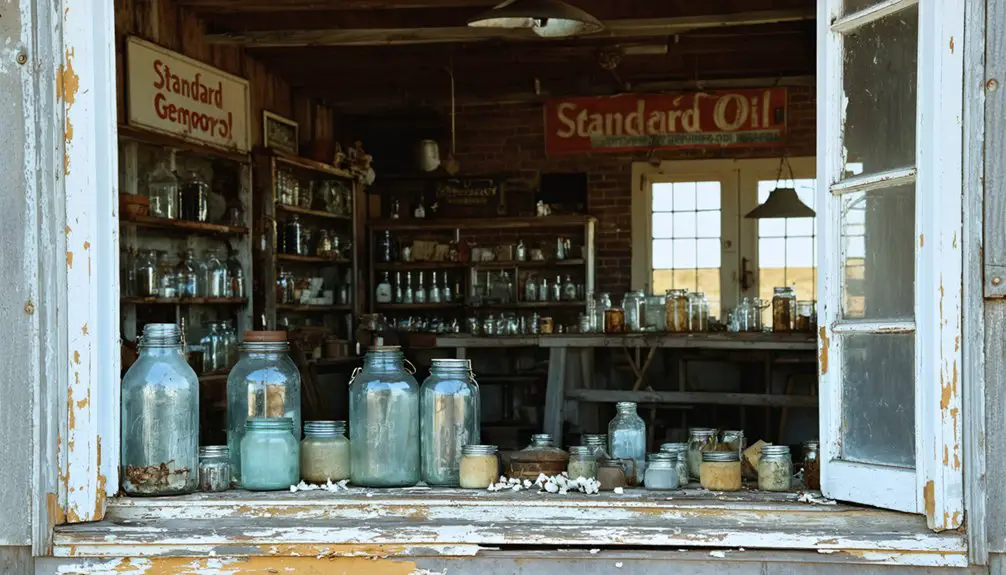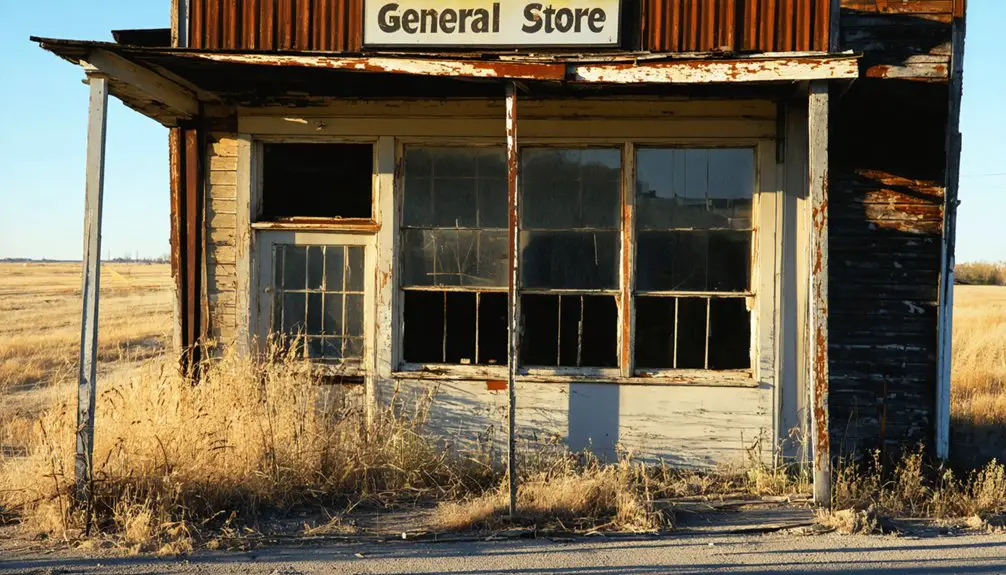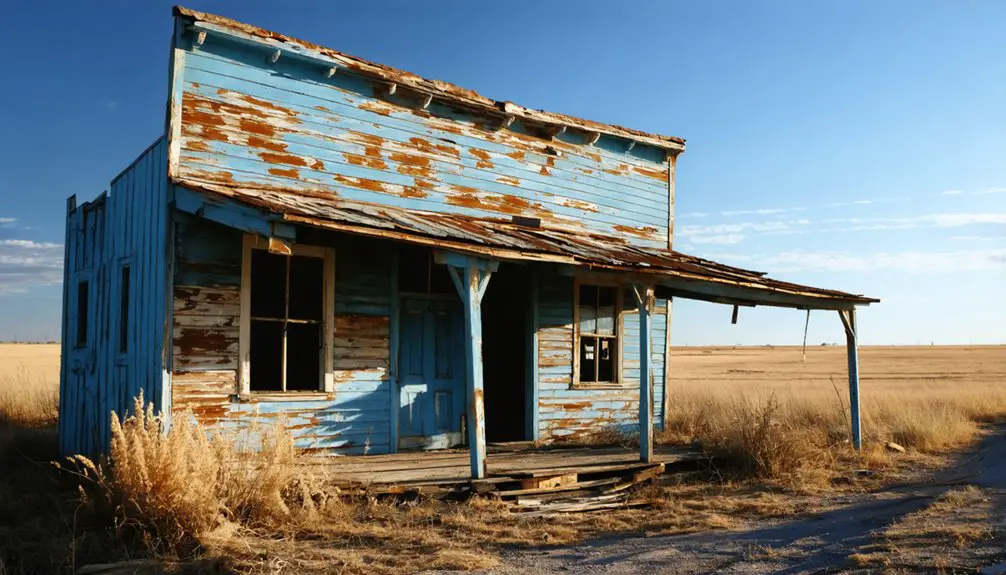You’ll find Phroso, Oklahoma located one mile north and 19 miles west of Fairview in Major County, at Section 21, Township 21 North, Range 15 West I.M. This ghost town emerged during a local economic boom, establishing its post office in 1900. The settlement featured a small business district centered around a general store, with churches and a one-room schoolhouse serving as community hubs. The town’s gradual decline mirrors the broader story of Oklahoma’s forgotten settlements.
Key Takeaways
- Phroso emerged during Oklahoma’s economic boom and is located one mile north and 19 miles west of Fairview in Major County.
- The town’s post office was established in 1900, marking the beginning of organized development and community growth.
- A small business district formed around a general store after the Cherokee Outlet opening in 1893.
- The community centered around a one-room schoolhouse and local churches, which served as social and educational hubs.
- Population declined over 80% from its peak due to resource depletion and economic collapse, leading to eventual abandonment.
The Rise and Fall of Phroso
While many Oklahoma ghost towns share similar origin stories, Phroso emerged during a local economic boom that likely centered on mining or resource extraction activities. The town was among the estimated two thousand ghost towns across Oklahoma.
Much like Acme Cement Company, businesses established operations to capitalize on the area’s natural resources during peak industrial times.
You’ll find its ghost town dynamics followed a classic pattern: promising beginnings marked by rapid development of homes, businesses, and community spaces to support the workforce.
The town’s economic shifts mirror those of other Oklahoma settlements that rose and fell with industry changes. When transportation routes changed and resources depleted, Phroso’s significance dwindled.
You can trace its decline through the familiar sequence of business closures, population exodus, and infrastructure decay. Like many of its contemporaries, the town couldn’t survive once its economic foundation crumbled, leading to the abandonment of buildings and eventual shift to its current ghost town status.
Location and Geographic Significance
Located deep in Major County, Oklahoma, Phroso stands as a monument to the region’s early settlement patterns.
Hidden in Oklahoma’s Major County, Phroso remains a silent testament to pioneers who once carved lives from untamed prairie.
You’ll find this ghost town approximately one mile north and 19 miles west of Fairview, positioned along a blacktop county road at Section 21, Township 21 North, Range 15 West I.M.
The geographic significance of Phroso reflects typical land use and settlement patterns of the Great Plains:
- Situated on gently rolling terrain ideal for agriculture
- Positioned within the section-township-range grid that defined post-Land Run parcels
- Connected via rural roadways but isolated from major transportation routes
- Surrounded by other ghost towns like Wheeless, illustrating the sparse rural development that once characterized western Oklahoma
The community established its post office in 1900, marking the beginning of its organized development. Today, you can access Phroso by vehicle, though its remote location continues to exemplify the challenging conditions early settlers faced. Modern attempts to locate Phroso often result in confusion due to inaccurate GPS waypoints based on historical data.
Early Settlement and Development
You’ll find that Phroso’s early settlement emerged shortly after the Cherokee Outlet opening, with pioneer families establishing homesteads in the rough terrain of western Oklahoma.
The settlement’s growth remained constrained by its geographic isolation and lack of railroad access, leading to modest commercial development centered around a small store. The trading post location thrived initially due to the absence of other nearby merchants serving the rural population.
Like Sumner which was established in 1893, Phroso’s community formation followed typical patterns of Cherokee Outlet hamlets, with early settlers relying on horseback and wagon travel to navigate the undeveloped landscape.
Railroad Influence and Growth
During the late 19th century, railroad expansion played a decisive role in shaping Phroso’s early development, as part of Oklahoma’s broader transformation through rail networks. The economic transformation of the region gained momentum as railroads connected isolated communities to larger markets, creating opportunities for trade and commerce. The MK&T Railway was the first to lay tracks in Indian Territory in 1870, marking a new era of connectivity. Between 1897 and 1907, dense branch networks emerged throughout the territory as settlers arrived and oil was discovered.
You’ll find that the railroad’s influence on Phroso reflected the typical pattern of Oklahoma’s settlement, with four key impacts:
- Major lines like the Frisco and Santa Fe created essential transportation corridors.
- Foreign investors, including Dutch and British capital, funded rail development.
- Agricultural products and resources could reach regional markets efficiently.
- New towns emerged along rail routes, following established trade paths.
The rail system’s expansion through Indian Territory ultimately connected Phroso to a growing network of over 6,000 miles of track by 1910.
Pioneer Families Arrive 1800s
As railroad development reshaped Oklahoma’s landscape, pioneer families began staking their claims in Phroso following the Land Rush of 1889.
You’ll find that these settlers faced intense pioneer struggles while establishing their 160-acre homesteads, building basic shelters from logs or sod, and cultivating the challenging prairie terrain.
Land disputes emerged as a significant issue, with overlapping claims creating tension between neighbors.
You might’ve encountered “Sooners” who’d illegally settled before the official land opening, leading to violent confrontations and legal battles.
The Department of the Interior stepped in by 1891, appointing special agents to investigate these conflicts.
Despite these challenges, settlers from diverse European backgrounds persevered, working together to establish farms, build community institutions, and adapt their agricultural practices to Phroso’s unique environmental conditions.
Similar to the Wichita Plains Culture, many settlers eventually transitioned to growing corn and other crops to sustain their communities.
The settlers’ hardships intensified during severe weather conditions, with dust storms devastating agricultural production and forcing many families to abandon their homesteads.
Early Business District Formation
Following the Cherokee Outlet opening in 1893, Phroso’s business district emerged around a small general store that served both Native American and settler populations.
The business district evolution reflected the typical pattern of community commerce in frontier Oklahoma, where transportation challenges shaped development.
You’ll find Phroso’s early commercial growth followed this progression:
- A general store established as the first business, providing essential supplies
- Post office designation that created a communication hub
- Grain storage facilities and feed barns to support local agriculture
- Hotels and specialty shops that emerged to serve the growing population
The railroad’s routing decisions ultimately influenced Phroso’s business district development, as towns that secured rail connections gained significant economic advantages over their neighbors.
The district’s layout centered around agricultural needs, reflecting the area’s wheat farming and cattle ranching economy.
Economic Activities and Industries

The economic foundation of Phroso, like many Black towns established in Oklahoma between 1890 and 1910, rested primarily on small-scale agriculture and local commerce.
You’d find general stores serving as retail hubs for surrounding farming communities, offering essential goods and creating a self-sustaining agrarian economy. Local trade flourished as residents avoided longer trips to distant towns.
The region’s economic cycles shifted dramatically with the rise of the mining industry in nearby areas like Picher after 1913.
While Phroso’s community commerce initially thrived through its stores, blacksmith shops, and boutiques, the industrial shift proved challenging.
The town’s agricultural decline accelerated during the Great Depression, as younger residents left for urban employment opportunities, ultimately contributing to Phroso’s transformation into a ghost town.
Daily Life and Community Structure
In Phroso’s heyday, you’d find residents gathering regularly at the local church and school for community events, from Sunday services to school plays and holiday celebrations.
The business district, though modest, served as a daily meeting point where townspeople would catch up on local news while visiting the post office or local shops.
Community bonds were strengthened through shared activities at dance halls and meeting spaces, where social events brought together multiple generations of farming and ranching families.
Social Gatherings and Events
Life in Phroso revolved around vibrant social gatherings that strengthened community bonds through various organized events and informal meetups.
You’d find the dance halls filled with energy during weekend socials, while community picnics brought families together for outdoor celebrations and seasonal festivities.
The town’s social calendar typically included:
- Weekly gatherings at the local general store, where you’d catch up on news and trade stories with neighbors.
- Seasonal harvest festivals and agricultural fairs that showcased local produce and craftsmanship.
- Cooperative work events like barn-raisings, where the community joined forces to help fellow residents.
- Holiday celebrations featuring parades, communal dinners, and special dances that united the townspeople in shared traditions.
These social connections formed the heartbeat of Phroso’s tight-knit community, creating lasting bonds between residents.
School and Church Activities
Daily rhythms in Phroso centered around its one-room schoolhouse and local churches, which served as twin pillars of community organization throughout the town’s existence.
You’d find community education extending beyond basic subjects like reading and arithmetic to include practical agricultural skills. The schoolteacher didn’t just instruct – they’d organize events and lead community initiatives.
Religious gatherings brought townspeople together weekly, with Baptist, Methodist, or Presbyterian services forming the spiritual backbone of Phroso life.
Both institutions hosted essential social functions, from holiday celebrations to town meetings. When these cornerstones began to crumble due to declining population and limited resources, they foreshadowed Phroso’s eventual fate.
The schools consolidated with neighboring towns, while churches struggled to maintain regular services, marking the beginning of the community’s dissolution.
Business District Interactions
While natural resource booms initially fueled Phroso’s commercial growth, the town’s business district emerged as more than just an economic hub.
The daily business interactions shaped vibrant community dynamics, creating lasting social bonds despite the town’s eventual decline.
You’d have found these key elements in Phroso’s commercial life:
- General stores served as central gathering spots where residents exchanged news and supplies, forming the backbone of local trading networks.
- Service stations and repair shops kept crucial machinery running while doubling as informal meeting places.
- Local establishments catered specifically to oil-field workers, providing essential goods and creating economic connections.
- Commercial activities centered along main thoroughfares, making the business district easily accessible to both residents and the transient workforce.
Transportation Networks and Access
Two major railroads historically served Phroso’s region, providing essential transportation links that shaped the town’s development and eventual decline.
You’ll find that these rail stops were vital lifelines, as no formal roads existed in the area during Phroso’s active years. The transportation evolution from horseback and wagon trails to rail networks defined the community’s early growth.
The access challenges were significant – you’d have faced slow, difficult overland travel without established roadways. As regional transportation improved elsewhere, Phroso’s isolation grew more pronounced.
Without proper roads, reaching Phroso meant grueling overland journeys while other areas enjoyed modern transportation advances.
When rail service was abandoned by mid-20th century, the town’s connectivity suffered further. Today, you can only reach Phroso via dirt roads, a reflection of the historical transport limitations that influenced its transformation into a ghost town.
Decline and Abandonment

After its initial period of growth, Phroso experienced a dramatic decline that mirrored many Oklahoma boomtowns of its era. The town’s downfall followed a pattern you’ll recognize from similar communities, where economic decline and demographic shifts led to an exodus of residents and businesses.
Consider these key factors that sealed Phroso’s fate:
- Economic collapse following resource depletion, with local businesses shuttering as population dwindled.
- Environmental contamination from resource extraction that made the area increasingly uninhabitable.
- Infrastructure decay as municipal services deteriorated and buildings fell into disrepair.
- Governmental responses including property buyouts and eventual dis-incorporation of the town.
The population dropped more than 80% from its peak, and remaining residents faced difficult choices about abandoning their homes as community resources vanished.
Remaining Structures and Artifacts
Despite extensive demolition efforts, several structures and artifacts remain in Phroso’s abandoned landscape, offering glimpses into the town’s mining heritage and abrupt evacuation.
You’ll find remaining homes standing defiantly against time, though most show severe structural damage with collapsed roofs and missing windows. The few surviving commercial buildings display haunting remnants of hasty departures – abandoned sweatshirts and “closed” signs still visible in former storefronts.
While the Mining Museum succumbed to arson, scattered mining artifacts persist behind safety fences, marking toxic containment zones. The water tower rises above the ruins, and you can still traverse the original roads, though they’re now overgrown.
Personal items left behind in buildings and abandoned artifacts tell the story of a community’s sudden exodus.
Historical Impact and Legacy

While Phroso’s physical structures have largely crumbled, its historical impact resonates through Oklahoma’s development narrative.
Like many ghost towns across the state, Phroso’s story reflects broader patterns of boom-and-bust cycles that shaped Oklahoma’s cultural heritage.
- You’ll find Phroso’s influence in historical narratives documenting the shift from rural to urban economies, marking a critical change in Oklahoma’s development.
- The town’s decline mirrors statewide demographic changes, with population losses exceeding 80% in many similar communities.
- Phroso contributed to establishing early regional identity through its social venues and community networks.
- Its legacy lives on through local folklore, newspaper archives, and historical documentation, preserving valuable insights into early Oklahoma Territory life.
Frequently Asked Questions
Are There Any Known Paranormal Activities or Ghost Stories From Phroso?
Among Oklahoma’s 130+ ghost towns, Phroso stands out for having zero documented ghost sightings or haunted locations. You won’t find any verified paranormal activities in historical records or local folklore.
What Native American Tribes Originally Inhabited the Area Before Phroso’s Establishment?
You’ll find the area’s rich tribal history included Wichita and Caddo peoples who lived there 2,000+ years ago, followed by Osage and Apache groups, each contributing distinct cultural significance.
Did Any Famous Outlaws or Historical Figures Ever Visit Phroso?
Truth is stranger than fiction, but you won’t find any outlaw legends or historical visits here. There’s no credible evidence that famous figures ever stopped in this small Oklahoma settlement.
What Happened to the Cemetery and Burial Records From Phroso?
You’ll find Phroso’s burial records are largely lost due to poor cemetery preservation. Only five memorial records survive publicly, while most graves remain unmarked and documentation scattered across county archives.
Were There Any Major Crimes or Significant Legal Cases in Phroso?
While unsolved mysteries and local legends may intrigue you, there’s no documented evidence of major crimes or significant legal cases in your search through the historical records of this settlement.
References
- https://www.youtube.com/watch?v=5d-wHDTIbb0
- https://en.wikipedia.org/wiki/List_of_ghost_towns_in_Oklahoma
- https://www.okhistory.org/publications/enc/entry?entry=GH002
- https://okcfox.com/news/local/oklahomas-secret-past-ghost-towns-of-oklahoma
- https://www.youtube.com/watch?v=xg8SpCG-wDg
- https://www.kaypratt.com/category/off_beaten_path/page/2/
- https://kellycodetectors.com/content/pdf/site_locator_books/OK.pdf
- https://okielegacy.net/journal/tabloid/index.php?ID=1116&vol=7&iss=50
- https://www.kaypratt.com/phroso-oklahoma-ghost-town/
- https://en.wikipedia.org/wiki/Grand



